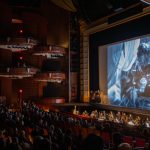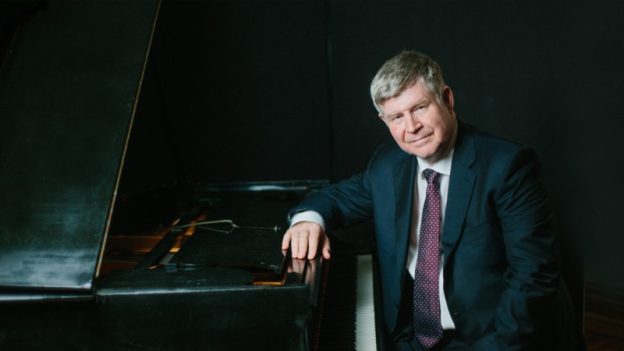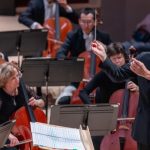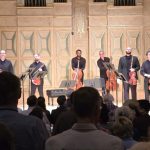November 6, 2025
Tenri Cultural Institute, Manhattan
New York, New York – USA
Ian Hobson, piano.
Robert SCHUMANN: Piano Sonata No. 1 in F-sharp minor, Op. 11
Robert SCHUMANN: Davidsbündlertänze, Op. 6
Ben Gambuzza | 12 NOV 2025
It’s finally over. Friday evening, after five years of performing all of Robert Schumman’s works for piano, including chamber music, British pianist Ian Hobson concluded his massive project with a program dedicated to the composer’s first piano sonata and his Davidsbündlertänze.
In a program titled “Florestan and Eusebius,” after Schumann’s wild and contemplative alter egos, respectively, Hobson barreled through movement after movement, Florestan-izing even the most subtle passages. He has a preternatural gift for rubato, but an unfortunate penchant for volume.
It’s a little bit of a surprise that Hobson chose to get obsessed with this particular composer. When I mentioned to a friend that I was going to hear him play Schumann, she said, “That’s weird. I thought he does pianoforte stuff.” Indeed he does. But that doesn’t mean he shies away from Romantic repertoire, only that he plays the piano like a pianoforte—the drier, clunkier ancestor of the modern piano. Maybe my taste is off, and maybe Hobson playing Schumann is like Glenn Gould playing Bach: unconventional but respectable. And yet I can’t help feeling that Hobson’s hands are too heavy for Schumann.
There were some extraordinary moments, to be sure, even as the harsh acoustics of the Tenri Cultural Institute in Manhattan deadened many of Schumann’s sultriest harmonies. (I don’t know whether to be thankful or apprehensive that, as one of Hobson’s publicists told me, his next, unannounced series will take place at St. Peter’s Church on Lexington Avenue.)
Hobson’s weighty playing was right at home in many parts of the Sonata, especially in the “Scherzo,” which was jumpy but grounded. In a recitative section, his right hand sang wonderfully. And his pedaling was a thing to behold. A couple of times, after a particularly gnarly section, he let the compounded dissonances ring out before he removed the pedal, leaving a bare, simple chord or tone for the audience to cherish. Many times, he used less pedal than is common for Schumann.
Some of the composer’s most introverted meditations were, under Hobson’s care, turned outward—private confessions on display for the public to hear, or, if they can’t stand Schumann’s sentimentality, to jeer. Hobson’s playing of the Sonata seemed to signal a rapture, as his focus on the microscopic parts of the music brought the overall form crashing down. Hobson knows the trees well but gets lost in the forest.
Hobson’s timing—between movements, during long pauses, throughout melodies—is impeccable. But his toggling between the chaotic sections of Florestan and the reflective passages of Eusebius is unsettling.
Actually, a guy behind me, I guess a pianist, put it best (even if he said it with a condescension that nauseated me): “He does sudden juxtapositions and they tend to shock; I do sudden juxtapositions and they sound like revelations.” The first part is true, although I can’t attest to this man’s own (apparently extraordinary) abilities. The finesse required to connect disparate moods in Schumann just wasn’t there with Hobson.
In the Davidsbündlertänze, a suite of eighteen movements named after the composer’s imaginary music society, and perhaps his greatest work (so much delight and depth in such short fragments), Hobson played even the most delicate movements with a budding violence. Overemphasis of the melody in the first movement, which begins with triumph and melts into uncertainty. Declaiming, rather than caressing, the painfully gorgeous half-tone dissonances in the fourth. Burying, rather than suspending, the airy chords in the seventh. Over-insisting on the countermelodies in the fourteenth. He doesn’t seem to enjoy the parts that are most enjoyable to play. There are a lot of those in the seventh, which is marked “Nicht schnell,” for “not fast,” an instruction Hobson seems to think is just a suggestion.
For all of Hobson’s apparent, abundant, admirable devotion to Schumann, the effect of his playing was like listening to a pianist read from a score (even though he was playing from memory) rather than interpret a score.
Despite the recital’s all-too-humanness, I left feeling fortified and inspired. I went home to my own piano and brought out, not Schumann, but Tchaikovsky’s The Seasons, which I had picked up at the Strand bookstore a few weeks ago. I played through the whole suite and thought I sounded better than ever. I’m sure this was due to Hobson. His—a professional’s—imperfect playing of a masterwork somehow convinced me that, if he can do it, I can do it. And isn’t that the best an artist can hope for? Sometimes, it’s not the best pianists who inspire you to get better, but the ones whose own level of mastery might, just might, be achievable. ■
EXTERNAL LINKS:
- Ian Hobson: music.illinois.edu/people/profiles/ian-hobson

Read more by Ben Gambuzza.
RECENT POSTS
 The Atlanta Opera conjures a night of enchantment as Glass’ score reawakens Cocteau’s ‘La Belle et la Bête’ • 20 Nov 2025
The Atlanta Opera conjures a night of enchantment as Glass’ score reawakens Cocteau’s ‘La Belle et la Bête’ • 20 Nov 2025 Jan Lisiecki on discipline, performance psychology, and programming for his Spivey Hall recital • 17 Nov 2025
Jan Lisiecki on discipline, performance psychology, and programming for his Spivey Hall recital • 17 Nov 2025




.png)